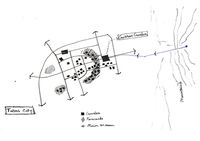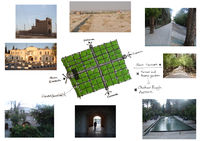Golshan Garden - Iran: Difference between revisions
Jump to navigation
Jump to search
Hamid.gohari (talk | contribs) No edit summary |
Hamid.gohari (talk | contribs) |
||
| Line 53: | Line 53: | ||
<gallery caption=" " widths="200px" heights="150px" perrow="4"> | <gallery caption=" " widths="200px" heights="150px" perrow="4"> | ||
Image: | Image:GOLSHAN.jpg | Tabas city and gardens | ||
Image: | Image:GOLSHAN2.jpg | Golshan garden pattern | ||
Image:yourimage.jpg | your image text and source | Image:yourimage.jpg | your image text and source | ||
Image:yourimage.jpg | your image text and source | Image:yourimage.jpg | your image text and source | ||
Revision as of 16:38, 4 November 2018
>>>Back to Case Studies Overview
>>>Glowing with Water
| Name | Golshan Garden | |
| Place | Tabas city | |
| Country | Iran | |
| Author(s) | Hamid Gohari | |
| World Heritage | ... | |
|
| ||
Why is this case relevant?
- Golshan Garden is one of the most important gardens and one of the unique historical heritage of Iran, which is estimated to be about 200 years old. This garden is located in Tabas city, in the range of connection of two main deserts, the Lut Desert and Kavir Desert. Generally, this garden is inherited the main elements from the Persian garden including the special structure, water and vegetation, and the palace. But specifically, this garden has different geometry, varied vegetation species, and special water distribution network, which make it unique one from the other Persian gardens. Golshan garden has evolved in the context of the Persian city and is one of the main features in the city’s structure. Over the years, its shape and function have changed to suit the needs of the city and created this amazing complex in the heart of the desert.
Which idea of ‘design with nature’ guides the design concept of this site?
- In this section you talk about the design concept of your area. Is it a highly maintained site, i.e. does the design with nature require intensive maintenance? Or does the site follow a more organic interpretation of nature? Which changes are expected if maintenance is missing?
Which challenges is this landscape facing?
- Here you discuss the types of negative impact you are observing but you can also mention new functions that could give a development opportunity
What would be your strategy for improvement?
Finally, please share some ideas of how you would initiate positive change for your heritage area
Image Gallery
- Yourimage.jpg
your image text and source
- Yourimage.jpg
your image text and source
- Yourimage.jpg
your image text and source
- Yourimage.jpg
your image text and source
- Yourimage.jpg
your image text and source
- Yourimage.jpg
your image text and source
References
- Author Year: Title, publisher, edition, page, ...
- etc.
- Website Year: Link, keyword, ...
- etc.


